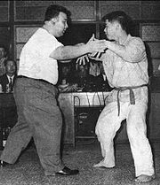
Hung I-Hsiang
Encyclopedia

Martial arts
Martial arts are extensive systems of codified practices and traditions of combat, practiced for a variety of reasons, including self-defense, competition, physical health and fitness, as well as mental and spiritual development....
who specialized in the internal Chinese styles
Neijia
Nèijiā is a term in Chinese martial arts, grouping those styles that practice nèijìng , usually translated as internal martial arts, occupied with spiritual, mental or qi-related aspects, as opposed to an "external" approach focused on physiological aspects...
of xingyiquan
Xingyiquan
Xingyiquan is one of the major "internal" or Wudang styles of Chinese martial arts. The word translates approximately to "Form/Intention Boxing", or "Shape/Will Boxing", and is characterized by aggressive, seemingly linear movements and explosive power...
, baguazhang
Baguazhang
Bāguàzhǎng is one of the three main Chinese martial arts of the Wudang school, the other two being Taijiquan and Xingyiquan. It is more broadly grouped as an internal practice...
and taijiquan.
Hung I-Hsiang was born in Taiwan
Taiwan Province
Taiwan Province is one of the two administrative divisions referred to as provinces and is controlled by the Republic of China . The province covers approximately 73% of the territory controlled by the Republic of China...
. He studied with Chang Chun-Feng
Chang Chun-Feng
Chang Chun-Feng, or Zhang Junfeng was a well-known Chinese martial artist who specialized in the internal styles of baguazhang, xingyiquan and taijiquan....
a master of internal Chinese martial arts from Northern China. Chang introduced these arts to Taiwan in 1948 when he moved there following the communist revolution in China. Initially, Chang met with resistance from mainlanders on Taiwan who objected to his teaching the secrets of internal martial arts to native Taiwanese such as Hung.
When Chang began teaching in the northern part of Taibei, his first group of core students included the three Hung brothers: Hung I-Hsiang, Hung I-Wen (*********) and Hong I-Mien (*********). It is said that Hung I-Hsiang was the xingyiquan
Xingyiquan
Xingyiquan is one of the major "internal" or Wudang styles of Chinese martial arts. The word translates approximately to "Form/Intention Boxing", or "Shape/Will Boxing", and is characterized by aggressive, seemingly linear movements and explosive power...
specialist, Hung I-Mien was the baguazhang
Baguazhang
Bāguàzhǎng is one of the three main Chinese martial arts of the Wudang school, the other two being Taijiquan and Xingyiquan. It is more broadly grouped as an internal practice...
specialist, and Hung I-Wen specialized in taijiquan .
After he had studied with Chang for several years, Hung often led classes for Chang. Because the internal martial arts were still very new in Taiwan, many curious people would come to test Chang's skill. Hung said that Chang would often send him out to show the visitors what the internal styles were all about. Many martial artists in Taiwan remember Hung as being someone who was involved in many fights, both in and out of the martial arts studio.
In the mid-1960s Hung I-Hsiang opened up his own school under the name Tang Shou Tao
Tang Shou Tao
Tang Shou Tao is a system of Chinese internal martial arts training founded in the 1950s and 1960s by Hung I-Hsiang , a well-known Taiwanese internal martial artist...
(*********).
Hung I-Hsiang internal arts training program included xingyiquan, baguazhang and Wu (Hao) style Taijiquan, Shaolin kung fu
Shaolin kung fu
Shaolin Kung Fu refers to a collection of Chinese martial arts that claim affiliation with the Shaolin Monastery.Of the multitude styles of kung fu and wushu, only some are actually related to Shaolin...
and qigong
Qigong
Qigong or chi kung is a practice of aligning breath, movement, and awareness for exercise, healing, and meditation...
. He suggests that students learn Shaolin kung fu when they are very young, progress to xingyiquan to learn how to develop internal power and then progress to baguazhang and taijiquan to learn how to refine the power. This is also the teaching sequence used by Hung's teacher, Chang Chun-Feng. Hung believed that, in practicing the xingyiquan five elements as an introduction to the internal martial arts, the student can clearly understand the way the body should be trained to move in the internal styles. If the student starts out in taijiquan it is very difficult to develop and understand internal power.
Many of Hung's students dominated the full-contact tournaments in Taiwan. One student, Weng Hsien-ming won the Taiwan full contact championships three years in a row. Another, Huang Hsi-I also usually won his all-Taiwan full contact tournaments with knock-outs. Other famous students of Hung I-Hsiang included Hsu Hung-Chi
Hsu Hung-Chi
Hsu Hung-Chi or Xu Hongji was a Taiwanese martial artist who specialized in the internal Chinese arts of xingyiquan, baguazhang and taijiquan....
, Lo Te-Hsiu
Luo Dexiu
Luo Dexiu or Lo Te-Hsiu is a Taiwanese martial artist who specializes in the internal Chinese styles of Xingyiquan, Baguazhang, and Taijiquan....
, and Su Dong Chen.
Link to Tang Shou Tao Israel
- www.abimoriya.co.il Website of Abi Moriya- student of Hong Yixiang, Yizong Tang Shou Federation, Israel
External links
BBC documentary on Hung I-Hsiang: Part 1, Part 2, Part 3, Part 4Links to Tang Shou Tao schools in North America
The following schools in North America were founded by students of Hung I-Hsiang or students of his students:- Hsing-I Martial Arts Institute (Mike Patterson)
- Little Nine Heaven Kung Fu School (James McNeil)
- New York Internal Arts (Tom Bisio)
- American Tang Shou Tao Association (Dale Shigenaga)
- North American Tang Shou Tao Association (Vince Black)
- The Sin Lung Kwoon (Mike Bingo)
- Shen Lung Tang Shou Tao Org. John Price

